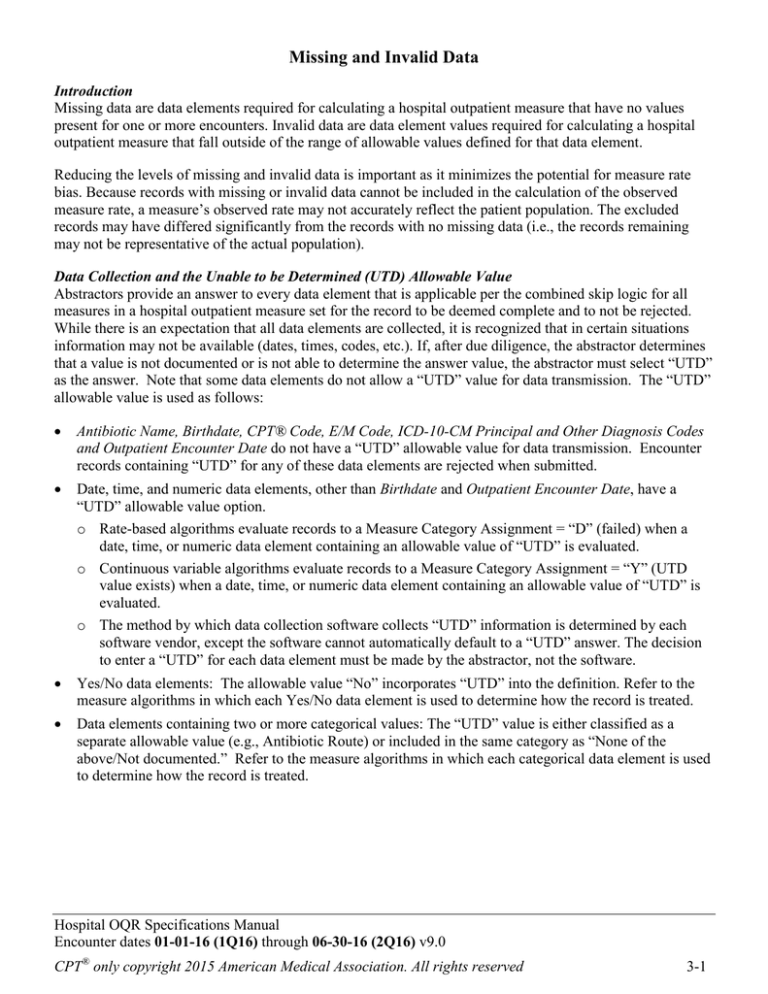
Material inside brackets ( [ and ] ) is new to th is Specifications Manual version.
Missing and Invalid Data
Introduction
Missing data are data elements required for calculating a hospital outpatient measure that have no values
present for one or more encounters. Invalid data are data element values required for calculating a hospital
outpatient measure that fall outside of the range of allowable values defined for that data element.
Reducing the levels of missing and invalid data is important as it minimizes the potential for measure rate
bias. Because records with missing or invalid data cannot be included in the calculation of the observed
measure rate, a measure’s observed rate may not accurately reflect the patient population. The excluded
records may have differed significantly from the records with no missing data (i.e., the records remaining
may not be representative of the actual population).
Data Collection and the Unable to be Determined (UTD) Allowable Value
Abstractors provide an answer to every data element that is applicable per the combined skip logic for all
measures in a hospital outpatient measure set for the record to be deemed complete and to not be rejected.
While there is an expectation that all data elements are collected, it is recognized that in certain situations
information may not be available (dates, times, codes, etc.). If, after due diligence, the abstractor determines
that a value is not documented or is not able to determine the answer value, the abstractor must select “UTD”
as the answer. Note that some data elements do not allow a “UTD” value for data transmission. The “UTD”
allowable value is used as follows:
•
Antibiotic Name, Birthdate, CPT® Code, E/M Code, ICD-10-CM Principal and Other Diagnosis Codes
and Outpatient Encounter Date do not have a “UTD” allowable value for data transmission. Encounter
records containing “UTD” for any of these data elements are rejected when submitted.
•
Date, time, and numeric data elements, other than Birthdate and Outpatient Encounter Date, have a
“UTD” allowable value option.
o Rate-based algorithms evaluate records to a Measure Category Assignment = “D” (failed) when a
date, time, or numeric data element containing an allowable value of “UTD” is evaluated.
o Continuous variable algorithms evaluate records to a Measure Category Assignment = “Y” (UTD
value exists) when a date, time, or numeric data element containing an allowable value of “UTD” is
evaluated.
o The method by which data collection software collects “UTD” information is determined by each
software vendor, except the software cannot automatically default to a “UTD” answer. The decision
to enter a “UTD” for each data element must be made by the abstractor, not the software.
•
Yes/No data elements: The allowable value “No” incorporates “UTD” into the definition. Refer to the
measure algorithms in which each Yes/No data element is used to determine how the record is treated.
•
Data elements containing two or more categorical values: The “UTD” value is either classified as a
separate allowable value (e.g., Antibiotic Route) or included in the same category as “None of the
above/Not documented.” Refer to the measure algorithms in which each categorical data element is used
to determine how the record is treated.
Hospital OQR Specifications Manual
Encounter dates 01-01-16 (1Q16) through 06-30-16 (2Q16) v9.0
CPT® only copyright 2015 American Medical Association. All rights reserved
3-1
Missing and Invalid Data
For rejected data to be accepted, errors must be corrected and the data resubmitted before the
transmission deadline.
•
The majority of general data elements that are missing data* cause the encounter record to be rejected.
Refer to the Data Dictionary Introduction in this manual for the complete list of general data elements.
•
In addition, if both the ICD-10-CM Principal Diagnosis Code and the CPT® Code data elements are
missing data*, the entire record will be rejected.
•
Not all patients have ICD-10-CM Other Diagnosis Codes. Records will be accepted for missing data for
this data element.
•
Measure-specific data elements that are missing data* cause the record to be rejected if any measure
algorithm results in a Measure Category Assignment = “X” (missing data). If no measure evaluates to a
category assignment of “X”, the record will be accepted.
•
General and measure-specific data elements that contain invalid data cause the record to be rejected.
•
All cases submitted with data related to Antibiotic Administration are required to be complete. Antibiotic
Name and Antibiotic Route must be complete for each dose of antibiotic submitted. A dose is considered
any row of antibiotics that contain allowable answer values for the above two listed data elements. If a
case is submitted with missing data for any dose of antibiotics, the case will be rejected. If the abstractor,
after due diligence, is not able to determine an answer, a value of “UTD,” if a valid allowable value, may
be selected for the applicable data element.
Note: *A missing value occurs when the abstractor does not select an answer for a data element (leaves it
blank) or the software incorrectly transmits a “null” instead of the correct value for a data element. A “UTD”
allowable value is not considered missing data.
Abstraction Software Skip Logic and Missing Data
Skip logic allows hospitals and vendors to minimize abstraction burden by using vendor software edit logic
to bypass abstraction of data elements not utilized in the measure algorithm. However, these bypassed
elements will negatively impact data quality and the hospital’s CMS chart audit validation results when
elements are incorrectly abstracted and subsequent data elements are bypassed and left blank.
The use of skip logic by hospitals and vendors is optional and not required. Hospitals should be aware of the
potential impact of skip logic on data quality, abstraction burden, and CMS chart audit validation scores.
Vendors and hospitals utilizing skip logic should closely monitor the accuracy rate of abstracted data
elements, particularly data elements placed higher in the algorithm flow.
Missing, Invalid, UTD Data Summary:
•
Missing Data – No data element value is present (blank or “null”).
•
Invalid Data – The data element value falls outside of the range of defined allowable values.
•
UTD – The allowable value of “UTD” is present for the data element.
Hospital OQR Specifications Manual
Encounter dates 01-01-16 (1Q16) through 06-30-16 (2Q16) v9.0
CPT® only copyright 2015 American Medical Association. All rights reserved
3-2



